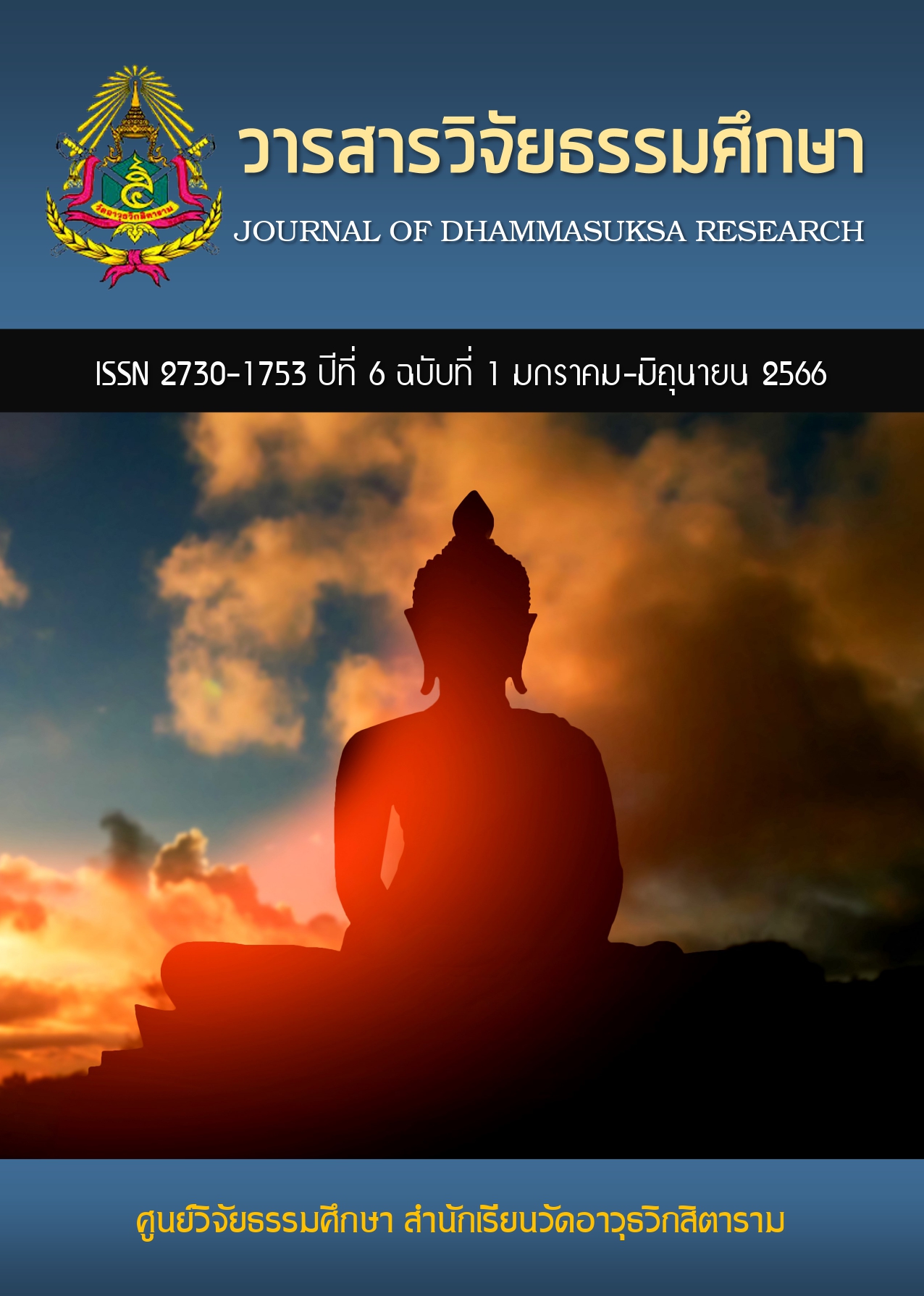การสื่อสารเชิงพุทธเพื่อดุลภาพชีวิตในสังคมบริโภคนิยม
คำสำคัญ:
การสื่อสาร, ดุลภาพชีวิตในสังคมบริโภคนิยม, พระพุทธศาสนาบทคัดย่อ
ดุษฎีนิพนธ์เรื่องนี้มีวัตถุประสงค์ในการทำวิจัยดังนี้ 1) เพื่อศึกษาการสื่อสารในสังคมบริโภคนิยม 2) เพื่อศึกษาการสื่อสารเชิงพุทธเพื่อดุลภาพชีวิตในสังคมบริโภคนิยม 3) เพื่อบูรณาการการสื่อสารในสังคมบริโภคนิยมด้วยการสื่อสารเชิงพุทธเพื่อดุลภาพชีวิต 4) เพื่อนำเสนอแนวทางและองค์ความรู้เกี่ยวกับ “การบูรณาการการสื่อสารเชิงพุทธเพื่อดุลภาพชีวิตในสังคมบริโภคนิยม” เป็นการวิจัยเชิงคุณภาพโดยการค้นคว้าข้อมูลจากพระไตรปิฎก เอกสาร งานวิจัยที่เกี่ยวข้องและข้อมูลจากการสัมภาษณ์ผู้ทรงคุณวุฒิ จำนวน 12 รูป/คน และได้นำข้อมูลมาศึกษาวิเคราะห์อภิปรายผลเชิงพรรณนา
ผลการวิจัยพบว่า
การสื่อสารในสังคมบริโภคนิยม เป็นมีการสื่อสารผ่านการใช้อินเตอร์เน็ต จึงเกิดเป็นสังคมออนไลน์ จนได้รับความนิยมเป็นอย่างมากโดยเฉพาะกลุ่มวัยรุ่น วัยทำงาน (GEN Y) จนสื่อเหล่านี้ได้เข้ามาเป็นส่วนหนึ่งของชีวิตผู้คนจำนวนมาก และเกิดเป็นการตลาดบนสื่อออนไลน์ทำให้การใช้ชีวิตได้รับอิทธิพลจากสื่อโฆษณา เพื่อการกระตุ้นให้มีพฤติกรรมการเสพหรือใช้จ่ายเงินซื้อสินค้าและบริการ ซึ่งส่วนใหญ่มาจากการรับสื่อโฆษณาผ่านสัมผัสทั้ง 5 การมองเห็น การได้ยิน การดมกลิ่น การชิมรส และการสัมผัส ตามเทคนิคการตลาดทางประสาทสัมผัสหรือ Sensory Marketing
การสื่อสารเชิงพุทธเพื่อดุลภาพชีวิตในสังคมบริโภคนิยม การสื่อสารที่พระพุทธเจ้าทรงสั่งสอนสามารถนำไปพัฒนาประยุกต์ใช้ได้กับการสื่อสารในทุกรูปแบบ ตามหลักของการสื่อสาร กระบวนการรับรู้ของมนุษย์ตามหลักธรรมผ่านอายตนะช่องทางการรับรู้ภายนอก ได้แก่ รูป เสียง กลิ่น รส สัมผัส เพื่อการมีชีวิตที่สมดุลในการดำเนินชีวิตในสังคมบริโภคนิยม จึงควรนำวิธีการสื่อสารของพระพุทธเจ้า ซึ่งได้แก่โยนิโสมนสิการ (ความคิด) ปาริสุสิทธิศีล 4 (ตัวควบคุม) อัตถะ 3 (ประโยชน์ใช้สอย) และวจีสุจริต (พูดดี) มาเพื่อควบคุมยังยั้งสิ่งที่เกิดจากอายตนะภายในและภายนอกในการอุปโภคบริโภค
การบูรณาการการสื่อสารเชิงพุทธเพื่อดุลภาพชีวิตในสังคมบริโภคนิยม เป็นการสื่อสารในสังคมบริโภคนิยมบูรณาการกับหลักธรรมทางพระพุทธศาสนา เพื่อให้ได้รูปแบบการการสื่อสารของการเสพสื่อที่เหมาะสมเพื่อนำมาเป็นแนวทางใช้ชีวิตให้มีดุลภาพ 5 ด้าน คือ 1) การเสพรูปลักษณ์ 2) การเสพเสียง 3) การเสพกลิ่น 4) การเสพรสชาติ และ 5) การเสพสัมผัส รูปแบบบูรณาการการสื่อสารเชิงพุทธเพื่อดุลภาพชีวิตในสังคมบริโภคนิยม ได้องค์ความรู้ คือ WIsDOM MODEL
เอกสารอ้างอิง
มาริสา จันทร์ฉาย. (2552). พฤติกรรมบริโภคนิยมของนักศึกษามหาวิทยาลัยสงขลานครินทร์. วิทยานิพนธ์ปริญญาศิลปศาสตรมหาบัณฑิต, สาขาวิชาพัฒนามนุษย์และสังคม, มหาวิทยาลัยสงขลานครินทร์.
วิไลลักษณ์ เสรีตระกูล. ปัจจัยในการทำนายค่านิยมแบบวัตถุนิยมของนักศึกษาในกรุงเทพมหานคร. เกษตรศาสตร์ (สังคม), /34/(1),/(2556): 17-29. [ออนไลน์]. แหล่งที่มา: https://dlink.me/6Ly2l.
BLT Bangkok. ตลาดบัตรเครดิตแข่งเดือดสะท้อนพฤติกรรมคนไทยออมน้อยใช้จ่ายหนัก. News & Trends In Cover Story. [ออนไลน์]. แหล่งที่มา: https://www.bltbangkok.com/NewsTrends. [8 พฤศจิกายน 2562].
SCB. กลยุทธ์มัดใจผู้บริโภค Gen Y. [ออนไลน์]. แหล่งที่มา: https://shorturl.asia/8h3uG. [10 ตุลาคม 2565].
ไฟล์ประกอบ
เผยแพร่แล้ว
รูปแบบการอ้างอิง
ฉบับ
ประเภทบทความ
หมวดหมู่
สัญญาอนุญาต
ลิขสิทธิ์ (c) 2023 วารสารวิจัยธรรมศึกษา

อนุญาตภายใต้เงื่อนไข Creative Commons Attribution-NonCommercial-NoDerivatives 4.0 International License.



